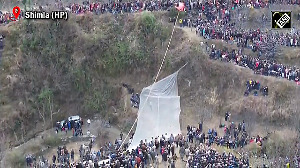All nine Adani stocks saw a rise in their share price in H1FY23, ranging from 6.1% in case of Adani Ports to 102% in case of Adani Power.

There was not much of a movement in India's broader equity market in the first half of the 2022-2023 financial year (HIFY23).
The benchmark BSE Sensex was down 1.9 per cent during the April-September period while NSE Nifty50 was down 2.1 per cent in the last six months.
In contrast, the period saw a big upheaval in the global financial markets due to the economic disruption caused by the Russia-Ukraine war and record high inflation in the advanced economies.
The United States benchmark index -- Dow Jones Industrial Average that has 30 stocks -- was down 15.7 per cent during the period.
The broader and tech heavy S&P 500 performed even worse, and is down 20 per cent during the period.
While Indian indices remained relatively unchanged, there was a lot of movement in individual stocks and sectors in HIFY23.
There was a sharp decline in the share price of the companies in the sectors such as information technology, mining and metals, consumer durables and real estate.
In the comparison, there was a strong rally in stocks from sectors such as auto and auto ancillaries, fast-moving consumer goods, banks and capital goods.
Among top stocks (in terms of market-capitalisation or m-cap) Hindustan Unilever (+31.6 per cent), ITC (+32.4 per cent), ICICI Bank (+18.2 per cent), Mahindra & Mahindra (+18.1 per cent) and Maruti Suzuki (+16.7 per cent) were the biggest movers in HI.
At the other end of the spectrum, the biggest laggards were Tata Consultancy Services (-19.6 per cent), Infosys (-25.9 per cent), Reliance Industries (-9.7 per cent), Wipro (-33.4 per cent) and Vedanta (-33.1 per cent).
In all, the combined m-cap of BSE500 stocks was up Rs 1.83 trillion during the period to close at Rs 247.2 trillion on September 30, up from Rs 245.4 trillion at the end of March this year.
The biggest movement in share price, however, occurred in Adani group stocks regardless of their sectors or industry.
All nine Adani stocks saw a rise in their share price in H1FY23, ranging from 6.1 per cent in case of Adani Ports to 102 per cent in case of Adani Power.
The nine Adani group stocks added Rs 7.28 trillion to their combined m-cap in H1FY23, the most among the country's key business groups.
Adani group combined m-cap zoomed 55.2 per cent to reach 20.49 trillion on September 30, up from Rs 13.2 trillion at the end of the last financial year.
The group's latest m-cap includes the figures for the recently acquired Ambuja Cement and ACC.
In contrast, other big business groups either saw their m-cap decline or gain marginally.
The Tata group companies' combined m-cap was down 13.5 per cent in H1Y23, to close at Rs 20.32 trillion from Rs 23.49 trillion at the end of FY22.
In the process, the group lost the pole position in the league table to the Adani group.
Similarly, the combined m-cap of Mukesh Ambani group companies, including Reliance Industries, was down 10.1 per cent in FY23 to close September at Rs 16.3 trillion -- from Rs 18.12 trillion -- at the end of FY22.
The AV Birla group's combined m-cap also saw a decline, going down 9.3 per cent during the period, to Rs 4.51 trillion from Rs 4.98 trillion, at the end of FY22.
The Rahul Bajaj group was somewhere in the middle and saw a 1.7 per cent rise in m-cap to hit Rs 9.04 trillion on September 30 against Rs 8.89 trillion at the end of FY22.
Going forward, analysts expect the sectoral and group dichotomy in stock performance to continue as the Indian economy and the corporate sector adjust to high inflation, rupee depreciation, rise in credit cost and slowdown in the world economy apart from and India's merchandise exports.

Feature Presentation: Aslam Hunani/Rediff.com












 © 2025 Rediff.com -
© 2025 Rediff.com -